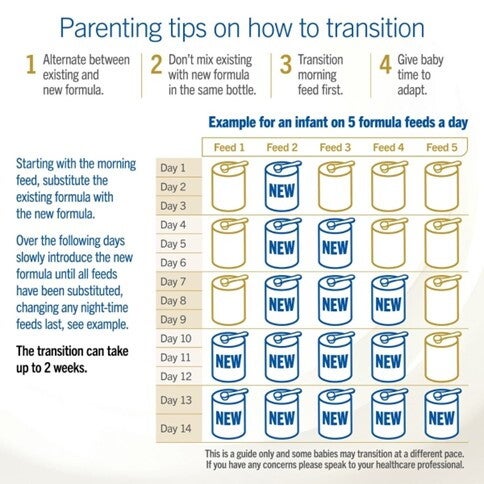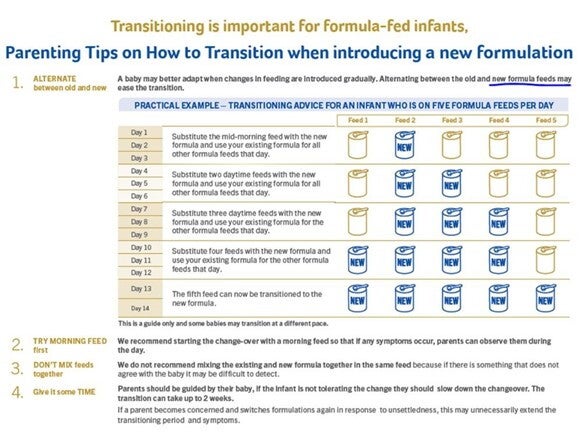
What is baby formula?
Baby formula is a specially formulated nutritional product designed to provide essential nutrients for infants who are not breastfed. Understanding what baby formula is and its nutritional ingredients is crucial for parents, especially when considering changing infant formulas to meet their baby's specific dietary needs or preferences. Your healthcare professional is the best source of this information. Babies under one year of age should not drink pure cow's milk as their main milk source, as it does not provide the appropriate balance of nutrients that infants require. For example, cow’s milk does not contain enough iron and has excessive amounts of protein for an infant. Baby formula is the only suitable alternative to breast milk in the first year of life.
Why might your baby prefer one formula over another?
While different brands or varieties of baby formula are designed to meet nutritional requirements of all babies, unfortunately that doesn’t mean every formula will suit every baby. Differences in formulas can influence a baby's acceptance of the formula, leading them to prefer one brand over another. If a baby finds a particular formula unappealing, they may refuse to drink it, which can be concerning for parents.
Common reasons for changing formula
- Feeding problems such as constipation, colic or regurgitation may result in the need to change formula;
- Digestive sensitivities may prompt changing formula and it’s not always easy to know why a baby doesn’t tolerate their current formulation. Some babies may experience discomfort or digestive issues with specific ingredients, prompting switching formula. A healthcare professional can help navigate the best formula solution for your baby.
- Intolerance to the carbohydrate in cow’s milk (lactose) may result in switching formulas while your baby isn’t tolerating it. This often occurs after a bout of gastro or a tummy bug, and for most baby’s it will just require a temporary change to a lactose-free formula until your baby recovers. A healthcare professional will help guide you through this.
- Allergy to the protein in cow’s milk is another reason why you will need to change infant formulas. Baby allergies will require proper diagnosis and a special formula recommendation from a medical professional.
- Flavour differences may mean one formula appeals to some and not others. Every formula will have subtle taste differences that appeals more to certain infants, while others may be less palatable.
- Nutritional needs change as your baby grows which may result in changing formula. Stage 1 baby formula is suitable from birth, whereas a stage 2 follow-on formula is suitable for infants from 6 months. From 12 months of age, your baby can progress to cow’s milk or use a toddler milk drink when energy or nutrient intakes may not be adequate.
Potential side effects of switching formula
It’s important to know that not all formulas suit all babies, however for most, if they don’t like the new feed initially, they will adapt to it over time, so don’t give up too quickly. Whenever you change from one feeding option to another it’s important to give your baby some time to adapt to the new feed. This can be up to 2 weeks.
The most common change parents see when transitioning to a new formula is a change in their baby’s bowel habits, this may be the smell, colour, frequency, texture, or all of the above! A change in their bowel movements, however, may not necessarily be related to feeding as bowel motions can be affected by a number of factors, including:
- Fluid intake
- Introduction of solids
- Age (as age increases the stool characteristics change)
- Illness and infections
- Medications
In some cases, you may find that your baby does not tolerate the new feed at all and you may need to try a different baby formula. If your baby experiences any severe side effects from changing the feed type, such as vomiting, diarrhoea or has an allergic reaction, you should seek the advice of your doctor or healthcare professional without delay.
Tips on how to transition between different formulas
A baby may better adapt when changes in feeding are introduced gradually. Alternating between the old and new feeds may ease the transition.

Alternate between existing and new formula
A baby may better adapt when changes in feeding are introduced gradually. Alternating between the old and new formula feeds may ease the formula transition.
Don’t mix existing with new formula in the same bottle
We do not recommend mixing the existing and new formula together in the same feed because if there is something that does not agree with the baby it may be difficult to detect.
Transitioning morning feed first
We recommend starting the change-over with a morning feed so that if any symptoms occur, parents can observe them during the day.
Give baby time to adapt
Always be guided by your baby. If your baby is not tolerating the change, slow down the changeover. The transition can take up to 2 weeks.
If you are concerned and switch formulas again in response to unsettledness, this may unnecessarily extend the transitioning period and symptoms. These tips may also apply when changing from formula to milk or a toddler milk drink from 12 months of age.

Frequently asked questions about changing formula
How to switch formula?
A baby may better adapt when changes in feeding are introduced gradually. Alternating between the old and new feeds may ease the formula transition. If your baby experiences any severe side effects from changing the feed type you should seek the advice of your doctor or healthcare professional without delay.
How to transition from formula to milk?
From 12 months of age, your baby can transition from formula to milk. Apart from cow’s milk, there are a number of other alternative milk drinks that may be suitable for your toddler. For example, oat or nut milks, or a toddler milk drink if energy and nutrient intakes are not being met. Similar to the advice on switching formulas, your toddler may better adapt to the transition from formula to milk if it's done gradually. Alternate between your baby’s formula and milk over a 2-week period.
What are the side effects of changing formula?
The most common side effects parents see when changing infant formula is a change in their baby’s bowel habits. However, a change in their bowel movements may not necessarily be related to feeding and it may be worth talking to your doctor about any side effects that concern you or are causing your baby a lot of discomfort. Regurgitation, colic and general fussiness are also commonly reported by parents when changing formula milk.
How quickly does changing formula affect a baby?
Not all babies react when changing formula milk. For some, switching formula may cause tolerance issues straight away. A gradual introduction of the new feed can help ease the transition and for some this can take up to 2 weeks.
Can I give my baby two different types of formula?<H3>
The only time where two different formulas may be appropriate is when transitioning to a new formula. Alternating between the old and new formula until your baby has accepted the formula transition may help ease the formula transition. Otherwise it is not recommended (and could be very confusing) to give your baby two different formulas at the same time. Using two different formulas ongoing may result in inadequate nutritional intake which could make your baby sick. It is also not recommend mixing two different formulas together in the same feed as it could be difficult to detect which one is causing them problems if there is something that does not agree with your baby.
Sources
Raising Children Network Website. Accessed at Baby formula & bottle-feeding for babies | Raising Children Network



